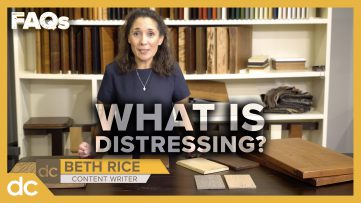What is distressed wood and what are the differences between distressing options? Why would I want my solid wood furniture distressed? These questions and more, answered by Beth at DutchCrafters. See if distressing is right for you. Explore your options for distressed finishes on your new wood furniture. Read about many wood finishes in our blog post, Wood Furniture Finishes. Or compare the distressing options with the Distressed Amish Hardwood Furniture page. If you have any questions, let us know! Contact us today! Transcript: What is distressing? Distressing creates an aged appearance for a time worn, vintage look. Distressing techniques can vary by woodshop, but many offer options of light to heavy distressing, as well as alternative methods such as hand planing, hand hewing, sandblasting, or wirebrushing. Standard distressing typically consists of woodworkers–and they’re really artists–using tools on the wood before or during the finishing process that simulates the wear of decades of use. Light distressing adds small pinholes, texture, and hand-rubbed glazing. Heavy distressing, by contrast, can create indentations and nicks, rasp markings and worm holes, and occasionally even simulated cracks. Two popular alternative methods offered are hand planing and hand hewing, which bring out natural character by roughing up a wood surface with blades. Hand planing uses a wide, flat, blade while hand hewing uses a narrow, curved blade. Wire brushing produces a weathered and worn look. A wire brush is run over the wood in the same direction as the wood grain before it is finished, creating long, clean lines across the wood. Sandblasting is the process in which sand or another medium is shot at a high speed through a machine across the surface of the wood. Sandblasting wood raises the grain, creating an uneven tone with a smooth finish. Learn the specifics of light to heavy distressing along with additional distressing techniques on our blog post, ‘Wood Furniture Finishes’, or visit our Learning Center’s ‘Distressed Hardwood’ page for more information. Any further questions about the differences? Give us a call, or leave a comment below.




